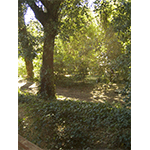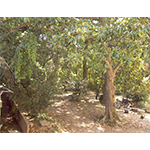Palazzo Serristori Garden
For its unusual location close to a mill-race, parallel to the course of the Arno, Benedetto Varchi placed this garden among the ten most important gardens of Florence. Enlarged the first time during the first half of the 16th century, it was composed of a vegetable garden with geometrically shaped beds, separated by a lemon-house, and a lawn with a well, embellished by potted citrus trees, as also visible in the plan by Buonsignori. Towards the mid 17th century, a loggia was built that ended at the river, so as to create a closer relationship with the River Arno. Successively, the garden’s divisions were redesigned by engineer Antonio Ferri.
The garden received its most important modifications in the course of the 18th century. After knocking down the walls that closed the mill-race on the Arno, the garden was enlarged and placed in direct contact with the river. Between 1803 and 1806, a wide pensile promenade, on a project by Giuseppe Manetti, was built on the wall of the mill-race, which thus become a waterway inside the garden, contributing to increasing its space with the reflected images. The promenade in the direction of the Porta San Niccolò was embellished by aedicules, belvederes and rest areas. It concluded at a Kaffeehaus built on one of the gables of the Ponte alle Grazie (formerly Ponte Rubaconte).
Alfredo Serristori inherited the property in 1856 and transformed the garden into the English-style wood, still in part visible today. Following the works to make Florence capital, the Lungarno Serristori was built, which resulted in the garden’s drastic reduction, the destruction of the promenade and Kaffeehaus, and the construction in 1873 of a new facade along the Arno. The garden today is much smaller and poorly maintained, thus not allowing its full use by tourist flows.
****************************
Texts by Graziano Magrini
English translation by Victor Beard
Last update 15/gen/2008





